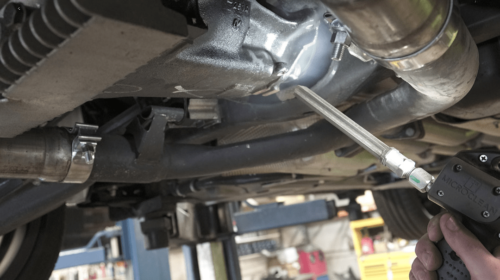
Renowacja Corvette 1970 – magia suchego lodu!
OPIS SYTUACJI
Renowacja samochodów polega na naprawie zniszczonych elementów samochodu w celu przywrócenia go do autentycznego stanu, czyli takiego, w jakim pojawiłby się w momencie wystawienia na sprzedaż.
Kompletna renowacja obejmuje nie tylko naprawę i czyszczenie części na zewnątrz samochodu, takich jak nadwozie, wykończenia, chromowane detale, koła, deska rozdzielcza i akcesoria, ale także części, które nie są tak widoczne, w tym silnik, bagażnik, rama, hamulce, układ chłodzenia silnika itp. Wszystkie części muszą zostać skrupulatnie sprawdzone, oczyszczone ze smaru i brudu oraz zmierzone zgodnie ze specyfikacjami fabrycznymi, a w razie potrzeby poddane obróbce mechanicznej lub ponownej produkcji w celu dostosowania ich do specyfikacji.
W procesie odnawiania swojej Corvette z 1970 roku, Kyle Wilson musiał wyczyścić deskę rozdzielczą, a także kilka innych części, zanim mógł ją profesjonalnie pomalować. Deska rozdzielcza zawiera szereg wskaźników, z których każdy musiał zostać sprawdzony, wyczyszczony i naprawiony lub wymieniony w celu przywrócenia samochodu do standardów zarówno operacyjnych, jak i kosmetycznych.
PROBLEM
Jedną z rozważanych metod czyszczenia było ręczne czyszczenie części wodą, detergentem i szczotką do szorowania, ale nie usunęłoby ono skutecznie wszystkich zanieczyszczeń. Roztwór na bazie rozpuszczalnika może być szkodliwy dla części, a także dla operatora w przypadku dłuższego kontaktu. Ponadto obie te opcje wymagają dużo czasu i pozostawiają wtórne odpady i resztki, co wiąże się z koniecznością dodatkowego czyszczenia.
Inne oceniane metody czyszczenia obejmowały piaskowanie i sodowanie, które uznano za nieopłacalne, ponieważ zarówno piasek, jak i soda mogłyby uszkodzić skomplikowane części i elektronikę.
“Potrzebowałem systemu czyszczącego, który byłby wystarczająco szybki i mocny do czyszczenia, ale także wystarczająco delikatny, aby nie uszkodzić części samochodu ani nie usunąć oryginalnych elementów” – powiedział Wilson. „Potrzebowałem również produktu, który mógłby dostać się do ciasnych szczelin, gdzie zwykłe narzędzia czyszczące, pędzle, ręczniki lub szmaty nie mogłyby dotrzeć”.
ROZWIĄZANIE
Maszyny do czyszczenia suchym lodem firmy Cold Jet wykorzystują nieścierne media w postaci cząsteczek CO2, które nie uszkadzają powierzchni ani sprzętu. Połączenie energii kinetycznej suchego lodu i efektów termicznych przerywa połączenie między brudem a powierzchnią, usuwając zanieczyszczenia. W przeciwieństwie do czyszczenia strumieniowego innymi środkami, czyszczenie suchym lodem nie pozostawia żadnych odpadów wtórnych, ponieważ cząsteczki suchego lodu sublimują po uderzeniu – przekształcając się z ciała stałego w gaz. Czyszczenie suchym lodem jest bezpieczne i nietoksyczne, nie powoduje dalszego zanieczyszczenia i zmniejsza lub eliminuje narażenie pracowników na niebezpieczne chemiczne środki czyszczące.
REZULTAT
Po pomyślnym wyczyszczeniu deski rozdzielczej Wilson zdecydował się wyczyścić także inne części samochodu. Używając systemu Cold Jet i3 MicroClean, Wilson wyczyścił wskaźniki, gniazdo zapalniczki, alternator, korek wlewu oleju, pokrywy zaworów, elementy sterowania ogrzewania, tylne światła, kompresor klimatyzacji, drzwi samochodu, spód maski i gaźnik.
Dzięki czyszczeniu suchym lodem Wilson był w stanie wyczyścić ramę na tyle delikatnie, aby uniknąć usunięcia farby i autentycznych numerów seryjnych i oznaczeń. Szczegółowo wyczyścił silnik i komorę silnika bez uszkadzania delikatnych elementów lub lakieru, a także usunął brud i zanieczyszczenia drogowe z podwozia bez konieczności wcześniejszego demontażu głównych elementów – skrzyni biegów, mechanizmu różnicowego, amortyzatorów, sprężyn, osi, obudowy wału i zawieszenia.
“Czyszczenie suchym lodem było idealnym rozwiązaniem do czyszczenia części samochodowych” – powiedział Wilson. „Był wystarczająco silny, aby wykonać zadanie, ale wystarczająco delikatny, aby nie uszkodzić części w trakcie procesu. Czyszczenie suchym lodem jest idealne dla elementów plastikowych, gdzie rozpuszczalniki mogłyby je zniekształcić i odbarwić. Ponadto, podczas czyszczenia komory silnika, byłem w stanie wyczyścić węże i przewody elektryczne bez uszkodzeń i odbarwień”.
